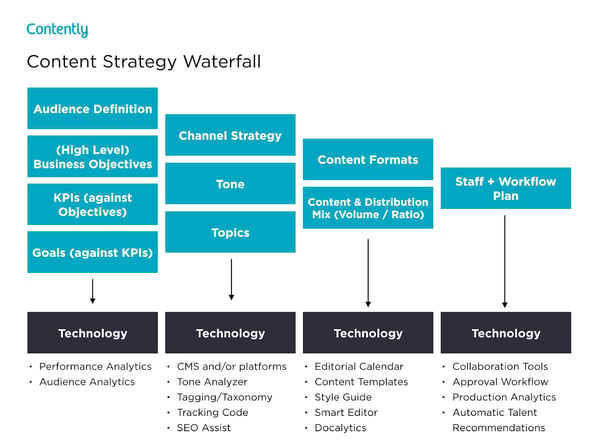How To Create An Online Marketing Plan
You did it. You've been spearheading your organization's content marketing efforts for a while now, and your team's performance has convinced your boss to fully adopt content marketing. There's one small problem, though. Your boss wants you to write and present a content marketing plan to them, but you've never done something like that before. You don't even know where to start. Fortunately, we've curated the best content marketing plans to help you write a concrete marketing plan that's rooted in data and produces real results. In this post, we'll discuss what a marketing plan is and how some of the best marketing plans implement strategies that serve their respective businesses. A marketing plan is a strategic roadmap that businesses use to organize, execute, and track their marketing strategy over a given time period. Marketing plans can include separate marketing strategies for the various marketing teams across the company, but all of them work toward the same business goals. The purpose of a marketing plan is to write down your tactics and strategies in an organized fashion. This will help keep you on track, and measure the success of your campaigns. Writing a marketing plan will help you think of each campaign's mission, buyer personas, budget, tactics, and deliverables. With all of this information in one place, you'll have an easier time staying on track with a campaign, noticing what works and what doesn't, and measuring the success of your strategy. Looking to develop a marketing plan for your business? Click here to download HubSpot's free Marketing Plan Template to get started. Depending on the company you work at, you might want to leverage a variety of different marketing plans. Here are just a few: Keep in mind that there's a difference between a marketing plan and a marketing strategy. A marketing strategy describes how a business will accomplish a particular mission or goal. This includes which campaigns, content, channels, and marketing software they'll use to execute on that mission and track its success. For example, while a greater plan or department might handle social media marketing, you might consider your work on Facebook as an individual marketing strategy. A marketing plan contains one or more marketing strategies. It is the framework from which all of your marketing strategies are created, and helps you connect each strategy back to a larger marketing operation and business goal. Let's say, for example, your company is launching a new software product it wants customers to sign up for. This calls for the marketing department to develop a marketing plan that'll help introduce this product to the industry and drive the desired signups. The department decides to launch a blog dedicated to this industry, a new YouTube video series to establish expertise, and an account on Twitter to join the conversation around this subject -- all of which serve to attract an audience and convert this audience into software users. Can you see the distinction between the business's marketing plan versus the three marketing strategies? In the above example, the business's marketing plan is dedicated to introducing a new software product to the marketplace and driving signups to that product. The business will execute on that plan with three marketing strategies: a new industry blog, a YouTube video series, and a Twitter account. Of course, the business might also consider these three things one giant marketing strategy, each with their own specific content strategies. How granular you want your marketing plan to get is up to you. Nonetheless, there are a certain set of steps every marketing plan goes through in its creation. Learn what they are below. Your first step in writing a marketing plan is to state your mission. Although this mission is specific to your marketing department, it should serve your business's main mission statement. Be specific, but not too specific. You have plenty of space left in this marketing plan to elaborate on how you'll acquire new customers and accomplish this mission. For example, if your business's mission is "to make booking travel a delightful experience," your marketing mission might be "to attract an audience of travelers, educate them on the tourism industry, and convert them into users of our bookings platform." Every good marketing plan describes how the department will track its mission's progress. To do so, you'll need to determine your key performance indicators, or "KPIs" for short. KPIs are individual metrics that measure the various elements of a marketing campaign. These units help you establish short-term goals within your mission and communicate your progress to business leaders. Let's take our example marketing mission from the above step. If part of our mission is "to attract an audience of travelers," we might track websites visits using organic page views. In this case, "organic page views" is one KPI, and we can see our number of page views grow over time. These KPIs will come into the conversation again in step 4, below. A buyer persona is a description of whom you want to attract. This can include age, sex, location, family size, job title, and more. Each buyer persona should be a direct reflection of your business's customers and potential customers. Therefore, it's critical that business leaders all agree on what your buyer personas are. You can develop buyer personas for free right here. Here's where you'll include the main points of your marketing and content strategy. Because there are a laundry list of content types and channels available to you today, it's critical that you choose wisely and explain how you'll use your content and channels in this section of your marketing plan. A content strategy should stipulate: A marketing plan explains what the marketing team is going to focus on. However, it also explains what the marketing team is not going to focus on. If there are other aspects of your business that you aren't serving in this particular plan, include them in this section. These omissions help to justify your mission, buyer personas, KPIs, and content. You can't please everyone in a single marketing campaign, and if your team isn't on the hook for something, you need to make it known. Your content strategy might leverage many free channels and platforms, but there are a number of hidden expenses to a marketing team that need to be accounted for. Whether it's freelance fees, sponsorships, or a new full-time marketing hire, use these costs to develop a marketing budget and outline each expense in this section of your marketing plan. Part of marketing is knowing whom you're marketing against. Research the key players in your industry and consider profiling each one in this section. Keep in mind not every competitor will pose the same challenges to your business. For example, while one competitor might be ranking highly on search engines for keywords you want your website to rank for, another competitor might have a heavy footprint on a social network where you plan to launch an account. With your marketing plan fully fleshed out, it's time to explain who's doing what. You don't have to delve too deeply into your employees' day-to-day projects, but it should be known which teams and team leaders are in charge of specific content types, channels, KPIs, and more. Ready to make your own marketing plan? Get started using this free template and take some inspiration from the real examples below. At HubSpot, we've built our marketing team from two business school graduates working from a coffee table to a powerhouse of hundreds of employees. Along the way, we've learned countless lessons that've shaped our current content marketing strategy, so we decided to illustrate our insights in a blog post to teach marketers how to develop a successful content marketing strategy, regardless of their team's size. In this comprehensive guide for modern marketers, you'll learn: A successful book launch is a prime example of data-driven content marketing. Using data to optimize your content strategy spreads more awareness for your book, gets more people to subscribe to your content, converts more subscribers into buyers, and encourages more buyers to recommend your book to their friends. When Shane Snow started promoting his new book Dream Team, he knew he had to leverage a data-driven content strategy framework. So he chose his favorite one: the content strategy waterfall, which is defined by Economic Times as a model used to create a system with a linear and sequential approach. To get a better idea of what this means, take a look at the diagram below: Snow wrote a blog post about how the content strategy waterfall helped him successfully launch his new book. After reading it, you can use his tactics to inform your own marketing plan. More specifically, you'll learn how he: You can use Snow's marketing plan to cultivate a better content strategy plan, know your audience better, and think outside the box when it comes to content promotion and distribution. When you're looking for a marketing plan for a new product, the Chief Outsiders template is a great place to start. Marketing plans for a new product will be more specific because they're targeted to one product versus an entire company's marketing strategy. After reading this plan, you'll learn how to: Writing a content plan is challenging, especially if you've never written one before. Buffer decided to help out the content marketing community. By sifting through countless content marketing strategy templates and testing the best, they crafted a content marketing plan template with instructions and examples for marketers who've never documented their content strategy. After reading Buffer's marketing plan template, you'll learn how to: Buffer's template is an incredibly thorough step-by-step guide, with examples for each section. The audience persona section, for example, has case studies of real potential audience personas like "Blogger Brian". If you're feeling overwhelmed by the process of creating a marketing guide, this can help ease you into it. Contently's content methodology works like a flywheel. Instead of applying an entirely new strategy to each new marketing campaign, they leverage the strategy of their previous marketing campaign to drive the next one. Similar to a flywheel, their content methodology needs an initial push of energy to get the gears in motion. What supplies this energy? Their content plan. Contently fleshed out their entire content plan in a blog post to help marketers develop a self-sustaining marketing process. After reading it, you'll learn how to: By applying a flywheel-like strategy to your own marketing efforts, you essentially take away the burden of applying new strategies to each individual marketing campaign. Instead, your prior efforts gain momentum over time, and dispel continual energy into whatever you publish next. An oldie, but a goodie -- Forbes published a marketing plan template that has amassed almost four million views since late 2013. To help you sculpt a marketing roadmap with true vision, their template teaches you how to fill out the 15 key sections of a marketing plan, which are: If you're truly lost on where to start with a marketing plan, this guide can help you define your target audience, figure out how to reach them, and ensure that audience becomes loyal customers. Venture Harbour's growth marketing plan is a data-driven and experiment-led alternative to the more traditional marketing plan. Their template contains five steps that are intended to be refined with every test-measure-learn cycle. The five steps are: These marketing plans serve as initial resources to get your content marketing plan started -- but to truly deliver what your audience wants and needs, you'll likely need to test some different ideas out, measure their success, and then refine your goals as you go. Editor's Note: This post was originally published in April 2019, but was updated for comprehensiveness. 
What is a marketing plan?
Featured Resource: Free Marketing Plan Template

Types of Marketing Plans
Marketing Strategy vs. Marketing Plan
How to Write a Marketing Plan
1. State your business's mission.
2. Determine the KPIs for this mission.
3. Identify your buyer personas.
4. Describe your content initiatives and strategies.
5. Clearly define your plan's omissions.
6. Define your marketing budget.
7. Identify your competition.
8. Outline your plan's contributors and their responsibilities.
7 Marketing Plan Examples to Help You Write Your Own
1. HubSpot's Comprehensive Guide for Content Marketing Strategy
Main objective: Content Marketing Plan
2. Shane Snow's Marketing Plan for His Book Dream Team
Main objective: Content Marketing Plan

3. Chief Outsiders Go-To-Market Plan for a New Product
Main objective: New Product Launch Marketing Plan
4. Buffer's Content Marketing Strategy Template
Main objective: Content Marketing Plan
5. Contently's Content Plan
Main objective: Content Marketing Plan
6. Forbes' Marketing Plan Template
Main objective: Content Marketing Plan
7. Venture Harbour's Growth Marketing Plan Template
Main objective: Growth Marketing Plan


Originally published Mar 23, 2021 7:00:00 AM, updated December 01 2021
How To Create An Online Marketing Plan
Source: https://blog.hubspot.com/marketing/marketing-plan-examples
Posted by: holcombwhopribed.blogspot.com

0 Response to "How To Create An Online Marketing Plan"
Post a Comment